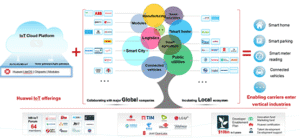Huawei’s AI Container Platform: Architecture, Capabilities, and How It Powers Real-World AI
Huawei’s AI Container Platform is a cloud-native system that combines container orchestration, AI workload optimization, and hardware acceleration to deliver scalable, high-performance AI solutions. Designed for enterprises and developers, it supports deep learning training, model inference, and real-world AI deployment across industries—powered by Huawei Cloud, Atlas AI hardware, and ModelArts integration.
Huawei has spent the last few years building a vertically integrated AI stack—from Ascend NPUs and software toolchains to cloud-native orchestration and model platforms. The result is an “AI container platform” that spans Huawei Cloud’s Cloud Container Engine (CCE) for Kubernetes, Ascend/CANN for accelerated compute, ModelArts for managed training/inference with custom images, and a growing ecosystem around MindSpore and Pangu models. For enterprises that need to run AI reliably across public cloud, private cloud, and edge—often under tight compliance and data-sovereignty constraints—Huawei’s approach is deliberately opinionated yet open where it matters: Docker/Kubernetes compatibility, standard images, and CNCF-aligned tooling. Huawei Cloud+1GitHub
This deep dive explains how Huawei’s AI container platform is put together, what’s unique about it (especially for Ascend NPU acceleration), how it compares to GPU-centric stacks, and how you can get hands-on—from building custom training images to deploying accelerated inference in Kubernetes.
1) What exactly is “Huawei’s AI container platform”?
Think of it as a layered stack that packages AI workloads into portable containers and runs them across clusters with hardware acceleration:
-
Cloud Container Engine (CCE): a fully managed Kubernetes service (public cloud and hybrid options) that’s API-compatible with upstream K8s and Docker. It handles cluster lifecycle, autoscaling, node pools, observability, and integrates add-ons for AI acceleration. Huawei Cloud+1
-
CCE AI Suite (Ascend NPU): a Huawei Cloud add-on that discovers and manages Ascend neural processing units inside Kubernetes. It enables “NPU-aware” scheduling, provides device plugins, and lets you create Ascend-accelerated nodes so pods can request NPU resources just like GPUs. Huawei Cloud SupportHuawei Documentation
-
Ascend / CANN: the Compute Architecture for Neural Networks, Huawei’s low-level toolkit, drivers, and runtime for Ascend hardware. It ships with container images and Dockerfiles, supports major AI frameworks, and is increasingly open-sourced to grow developer adoption. GitHubTechRadar
-
ModelArts (managed AI): Huawei Cloud’s managed platform for training, tuning, and serving models—including the ability to bring your own container images for PyTorch/MindSpore/others, so you can standardize environments across dev/test/prod. Huawei Cloud Support
-
MindSpore & official images: Huawei’s AI framework (with CPU/GPU/NPU backends) publishes Docker images, making it straightforward to pull a baseline and extend. Docker Hub+1
-
Models & agents: On top sit Pangu foundation and industry models, along with an agent platform that also supports select third-party models—useful when you want to align app logic with managed serving images and enterprise governance. Huawei CloudHuawei Cloud Support
Why this matters: instead of stitching together bespoke nodes, device plugins, and runtime images, Huawei ships a “reference path” for Ascend-accelerated Kubernetes plus a managed option (ModelArts) for teams that prefer a higher abstraction.
2) What’s new in 2024–2025: performance, openness, and recognition
A few developments make Huawei’s platform especially notable lately:
-
Open-sourcing more of CANN: Huawei announced an expanded open-source push for its CANN toolchain, positioning it as an alternative to CUDA for Ascend hardware—partly to widen developer access and decrease vendor lock-in. TechRadar
-
Unified Cache Manager (UCM): a new software layer that optimizes AI I/O paths when HBM memory is constrained, reportedly reducing latency and boosting throughput by reorganizing data across HBM, DRAM, and SSD. For containerized LLM training/inference, this can be a lifeline under export restrictions or tight memory budgets. Tom’s Hardware
-
Gartner & industry nods for container leadership: multiple reports and trade outlets highlighted Huawei Cloud’s strong placement for container management, citing scale across public/hybrid/edge and AI-driven operations—context that reinforces CCE as a viable enterprise backbone for AI workloads. Data Center DynamicsTechnology MagazineCapacity MediaAI Magazine
3) Architecture: how AI acceleration works in Kubernetes (CCE)
At the heart of containerized AI is the ability for pods to request accelerators and for the scheduler to place them on the right nodes. In Huawei Cloud:
-
Install CCE AI Suite (Ascend NPU) on your cluster. This deploys device plugins, DaemonSets, and admission controllers to expose Ascend devices into Kubernetes. Pods can then request NPU resources via extended resource types, just as you would request
nvidia.com/gpuon a GPU cluster. Huawei Cloud SupportHuawei Documentation -
Use Ascend-enabled node pools. When you create node pools with Ascend cards, the suite labels and taints nodes appropriately so that AI workloads land where the hardware exists.
-
Pull CANN-based container images. Huawei publishes Ascend/CANN container images and Dockerfiles that package the runtime, drivers, compilers, and framework build dependencies. Teams can extend these images with code, datasets, and model artifacts. GitHubDocker Hub
-
Run training/inference jobs. CCE integrates with common K8s patterns (Jobs, Deployments, StatefulSets) and supports autoscaling (HPA/VPA), service meshes, and observability stacks—so you can instrument model performance and cost. Huawei Cloud
For teams that prefer a managed control plane, ModelArts lets you define training or real-time inference with custom container images while Huawei handles the orchestration, logging, and scaling. This is effective for regulated environments that need consistent base images across dev/stage/prod. Huawei Cloud Support
4) Images and runtimes: choosing your base
Huawei’s ecosystem supports multiple routes:
-
MindSpore images: a good default if you’re using Huawei’s framework. These images (CPU/GPU/NPU variants) are published on Docker Hub and docs, and they play nicely with ModelArts. Docker Hub+1
-
Ascend/CANN images: the closer-to-metal option for performance tuning on Ascend hardware, with Dockerfiles on GitHub so you can rebuild or audit your base. GitHub
-
Bring-your-own PyTorch/TensorFlow: via ModelArts’ custom image mechanism, you can package your favorite frameworks and libraries (e.g., tokenizers, Triton, Ray, XLA) and run them on CPU/GPU. Ascend support requires the matching CANN components and framework builds. Huawei Cloud Support
Tip: Standardize on a minimal set of base images (for training, batch inference, real-time inference) and version them semantically. Treat images as artifacts: scan for CVEs, sign them, and keep SBOMs.
5) Models and MLOps: Pangu + third-party options
Huawei’s Pangu models (now on v5.0) target enterprise verticals—finance, government, manufacturing, telecom—with text, vision, and scientific computing variants. On Huawei Cloud, the model platform also supports select third-party models (including “deep thinking” models such as DeepSeek), which you can wire into agent frameworks and app backends. For operators, that means you can containerize and serve both Pangu and non-Pangu models behind the same mesh, gateway, and observability stack. huaweiHuawei CloudHuawei Cloud Support
Agentic apps: With containerized backends, you can compose tools (RAG, vector DBs, function calling) alongside models. Run retrieval/indexers as microservices, expose function registries via sidecars, and use K8s NetworkPolicies to fence off egress for compliance.
6) Performance engineering on Ascend: beyond “just containers”
Running AI in containers is trivial; running it fast isn’t. Huawei’s stack adds a few knobs:
-
CANN graph optimizations: compilers and kernels tailored for Ascend NPUs to accelerate training/inference graph segments. Container images ship the toolchain so you can reproduce builds. GitHub
-
Unified Cache Manager (UCM): for memory-bound LLMs, UCM orchestrates data between HBM/DRAM/SSD to reduce stalls and improve effective throughput—particularly relevant where HBM supply is limited. This is complementary to container-level optimizations (numactl, page cache sizing, I/O schedulers). Tom’s Hardware
-
NUMA & affinity: pin worker processes per NPU, align CPU threads with I/O queues, and isolate background daemons from hot cores.
-
Image layering strategy: keep driver/runtime layers separate from app layers; pre-warm common layers across nodes to slash cold-start times.
7) Typical deployment patterns
A. Managed training on ModelArts (BYO image)
-
Build a PyTorch/MindSpore training image (from CANN or MindSpore base).
-
Push to a private registry.
-
In ModelArts, create a training job, select custom image, mount datasets/obs buckets, and configure distributed parameters.
-
Scale experiments and track metrics, artifacts, and logs in the console. Huawei Cloud Support
B. Real-time inference on CCE with Ascend NPUs
-
Create an Ascend node pool and install CCE AI Suite (Ascend NPU).
-
Deploy a Deployment with resource requests for NPUs (e.g.,
resources.limits: ascend.huawei.com/npu: 1). -
Use a Service + Ingress/Gateway to expose the model; add autoscaling via HPA on QPS or latency SLI.
-
Observe with Prometheus/Grafana and ship traces via OpenTelemetry. Huawei Cloud SupportHuawei Cloud
C. Hybrid “AI-in-a-box” + Cloud
Chinese enterprises often prefer on-prem boxes for data governance, synchronizing models and telemetry to the cloud for fleet ops. Huawei has been a visible vendor in this AI-in-a-box movement, partnering with local LLM providers to bundle hardware + software stacks. In Kubernetes terms, this becomes a fleet of clusters with centralized image registries, policy, and observability. Financial Times
8) How it compares: Huawei vs GPU-centric stacks
-
CUDA vs CANN: Nvidia’s CUDA dominates GPU ecosystems; Huawei’s CANN is the analog for Ascend NPUs. The recent open-source push aims to broaden adoption and documentation—critical for ISVs to port kernels and ops. TechRadar
-
HBM constraints: Where access to high-bandwidth memory or latest GPUs is restricted, UCM and NPU-optimized data paths can be decisive for feasibility. Tom’s Hardware
-
Kubernetes parity: On orchestration, Huawei’s CCE is upstream-compatible with kubectl and native APIs, which reduces lock-in fears and lets you reuse manifests and Helm charts you already maintain. Huawei Cloud
-
Model ecosystem: If your shop relies on MindSpore or has workloads ported to Ascend, Huawei’s stack is compelling. If you’re GPU-first and deeply tied to CUDA-specialized frameworks, weigh porting effort vs performance/cost benefits.
9) Security and governance
Any enterprise AI platform needs repeatable security controls:
-
Supply-chain security: sign images (cosign/notary), store SBOMs, and scan for CVEs in base layers (CANN, MindSpore).
-
Runtime policies: use PodSecurity/OPA Gatekeeper to enforce non-root runs, read-only filesystems, and controlled host access.
-
Network controls: apply NetworkPolicies to restrict model pods and egress; use service mesh mTLS for east-west traffic.
-
Data governance: keep training data on encrypted volumes and use OBS (object storage) lifecycle rules. For multi-tenant clusters, isolate by namespace + node pool and consider per-tenant registries.
-
Watermarking and content risk: if serving generative models, add output filters and watermarking where supported, and log prompts/outputs for audit (respecting privacy).
10) Cost optimization
-
Right-size accelerators: Match NPU count to model shards; for small/medium models, over-provisioning accelerators kills utilization.
-
Autoscale aggressively: Use HPA for real-time inference and KEDA for event-driven batch queues.
-
Layer caching: Pre-pull base images on node pools; keep app layers thin to reduce egress costs and rollout time.
-
Checkpointing & spot: For training, checkpoint frequently and use preemptible nodes for non-critical jobs.
-
Use UCM on memory-bound LLMs: If HBM is scarce, UCM-style tiering can stretch hardware without linear cost growth. Tom’s Hardware
11) Step-by-step: building a custom Ascend training image
-
Start from a CANN base (or MindSpore base if you prefer).
-
Install framework builds compatible with CANN version (PyTorch for Ascend or MindSpore).
-
Add libraries: tokenizers, datasets, distributed launchers, NCCL-equivalent for Ascend if required.
-
Create an unprivileged user, set working dir, and copy in entrypoints for training.
-
Bake tests: include a smoke test (e.g., micro-batch training) that asserts NPU visibility.
-
Push to registry, then define a ModelArts training job or a K8s Job with NPU requests on CCE. GitHubHuawei Cloud Support
12) Observability that matters for AI
-
Hardware metrics: Collect per-NPU utilization, memory bandwidth, temperature, and error rates; expose as Prometheus metrics.
-
Model SLIs: latency p50/p95, tokens/sec, throughput per node, queue depths.
-
Dataflow: log dataset cache hit rates and preprocessor latencies—these often dominate costs.
-
Drift and quality: run scheduled batch evaluations and log scorecards; containerization makes these repeatable and portable across environments.
13) Edge and “micro-cloud” scenarios
Huawei’s platform can extend to edge: run trimmed K8s clusters with Ascend modules in factories, campuses, or telco POPs. Use image policies to pin versions, ship models via registries, and replicate only deltas. Telemetry and policy can sync back to the cloud. Latency-sensitive inference (vision, speech) benefits from on-prem NPUs; batch jobs route to regional clouds.
14) Real-world use cases
-
Finance: low-latency document understanding and risk scoring on private data, deployed as containerized microservices on CCE with NPUs for acceleration.
-
Manufacturing: vision inspection + predictive maintenance; Pangu industry models provide templates while edge clusters handle on-site inference. Huawei Cloud
-
Public sector: document compliance, city-scale video analytics (with careful governance). Pangu CV and multimodal models are designed for these workflows. Huawei Cloud
-
Telecom: RAG for support agents; inference autoscaling on CCE to absorb traffic spikes.
15) Pros and cons at a glance
Strengths
-
End-to-end stack: Ascend hardware ↔ CANN ↔ images ↔ Kubernetes (CCE) ↔ ModelArts.
-
Strong Kubernetes compatibility and managed cluster options. Huawei Cloud
-
Focus on open tooling (CANN), growing image ecosystem, and enterprise features. TechRadar
-
Emerging UCM solution to mitigate HBM scarcity for LLMs. Tom’s Hardware
-
Industry recognition for container management breadth. Data Center DynamicsTechnology Magazine
Trade-offs
-
Porting effort if your stack is deeply CUDA-optimized.
-
Documentation and third-party library maturity can vary by framework/version on Ascend.
-
Multi-region availability and partner ecosystem differ outside China; check local compliance requirements and support channels.
16) Getting started checklist
-
Choose your path: Start with ModelArts (fastest) or CCE (more control).
-
Pick a base image: MindSpore (simpler) or CANN (maximum performance/control). Docker HubGitHub
-
Provision Ascend nodes (CCE) and install CCE AI Suite. Huawei Cloud Support
-
Containerize your workload: entrypoints for train/serve, environment variables for sharding, secrets for storage.
-
Wire observability: expose metrics, traces, and logs; set SLOs for latency and tokens/sec.
-
Harden security: sign images, enforce PodSecurity, lock down egress.
-
Optimize: test UCM for memory-bound LLMs; profile I/O, not just compute. Tom’s Hardware
17) Frequently asked questions
Q1: Can I run standard K8s manifests and Helm charts on CCE?
Yes. CCE is compatible with native Kubernetes APIs and kubectl, and incorporates updates from upstream communities. This helps you reuse IaC you already maintain. Huawei Cloud
Q2: Do I have to use MindSpore?
No. MindSpore is well-supported, but ModelArts and CCE support custom images for frameworks like PyTorch. For Ascend acceleration, ensure your framework build aligns with the CANN version. Huawei Cloud Support
Q3: How do pods “see” the NPU?
Install CCE AI Suite (Ascend NPU); it provides device plugins and node setup to expose NPUs as schedulable resources to pods. Huawei Cloud Support
Q4: What about performance vs GPUs?
It’s workload-dependent. Huawei is investing in CANN openness and tooling to ease porting and optimization. Test your models; UCM may help when memory bandwidth is the bottleneck. TechRadarTom’s Hardware
Q5: Can I combine Pangu models with third-party LLMs?
Yes. Huawei’s platform exposes Pangu and supports certain third-party models within its agent/dev platform, which you can serve behind the same containerized infrastructure. Huawei Cloud Support
18) The bottom line
Huawei’s AI container platform isn’t just “Kubernetes plus accelerators.” It’s a systematic stack that couples Ascend NPUs and the CANN toolchain with a Kubernetes service (CCE) and a managed AI layer (ModelArts)—and then rounds it out with framework images (MindSpore), foundation models (Pangu), and new software (like UCM) for memory-bound LLMs. For organizations that need enterprise-grade, containerized AI in regions where Huawei Cloud is strong—or that are adopting AI-in-a-box on-prem architectures—the platform offers a credible path to scale AI with governance and cost control. Huawei Cloud+1Tom’s HardwareFinancial Times
If your workloads are tied to CUDA, expect some engineering to port kernels and ops. But the container foundations are familiar: Docker images, Kubernetes APIs, GitOps pipelines. That familiarity—paired with an increasingly open CANN ecosystem and industry validation for Huawei’s container management—means teams can bring modern MLOps practices to Ascend hardware with less friction than expected. TechRadarData Center Dynamics
Sources & further reading
-
Cloud Container Engine (CCE)—Kubernetes service and compatibility details. Huawei Cloud+1
-
CCE AI Suite (Ascend NPU)—device plugin/add-on docs for NPU scheduling. Huawei Cloud SupportHuawei Documentation
-
Ascend/CANN container images—Dockerfiles and runtime assets for Ascend. GitHub
-
ModelArts custom images—building your own images for training/inference. Huawei Cloud SupportHuawei Documentation
-
MindSpore images—official Docker Hub repo. Docker Hub+1
-
Pangu models (v5.0)—capabilities and industry focus. huaweiHuawei Cloud
-
CANN open-source news—context on Huawei’s CUDA alternative. TechRadar
-
UCM memory tiering—throughput/latency claims under HBM constraints. Tom’s Hardware
-
Gartner/container recognition—industry coverage of Huawei Cloud’s placement. Data Center DynamicsTechnology MagazineCapacity MediaAI Magazine







